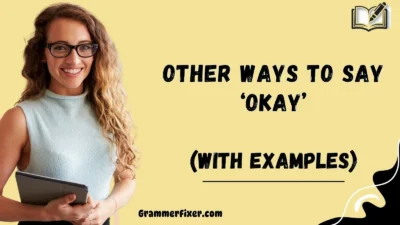Finding the right words matters more than we think. Whether in professional emails, business meetings, or team communications, using warm, thoughtful, and well-chosen language can make your message feel personal and meaningful. While “best practice” is a recognized standard in many industries, sometimes it feels overused, too formal, or not perfectly suited for the tone you want.
That’s where fresh alternatives come in — they help you connect with your audience, show intentionality, and tailor your message for clarity, professionalism, and engagement.
What Does “Best Practice” Mean?
“Best practice” refers to a proven and widely accepted method for achieving the best possible results in a given field or situation.
It represents the highest standard of performance, often based on experience, research, and evidence.
Businesses and professionals use it to ensure consistency, efficiency, and quality in their operations.
In short, it’s the recommended way to do something because it has been shown to work effectively and reliably.
When to Use “Best Practice”?
Use “best practice” when you want to convey authority, credibility, and confidence in your approach. It’s common in policies, training documents, operational procedures, and professional discussions where clarity and reliability are paramount.
Is It Professional/Polite to Say “Best Practice”?
Yes — “best practice” is considered formal, professional, and polite. However, it can sometimes feel jargon-heavy or impersonal in casual settings, which is why varied expressions can be useful.
Pros or Cons
Pros:
- Signals expertise and credibility
- Implies a tested, reliable method
- Universally understood in most professional contexts
Cons:
- Can feel overused or generic
- May sound too rigid in creative or informal settings
- Risks alienating non-expert audiences if used without explanation
1. Proven Method
Meaning: A technique or approach that has been tested and validated for consistent results.
Detailed Explanation: This phrase replaces “best practice” while still emphasizing credibility and evidence-based success.
Scenario Examples:
- “Our proven method for onboarding new employees reduces turnover by 30%.”
- “We’ll apply a proven method to streamline reporting.”
Best Use: In presentations, training, and documentation where results and evidence matter.
Worst Use: In casual conversations with non-experts — may sound too formal.
Tone: Authoritative, confident, reliable.
2. Gold Standard
Meaning: The highest recognized level of quality and excellence in a field.
Detailed Explanation: Implies that this is the benchmark against which all others are measured.
Scenario Examples:
- “This model is considered the gold standard in cybersecurity protocols.”
- “Our service is the gold standard for client care.”
Best Use: When emphasizing superiority and recognition.
Worst Use: Overstating minor achievements — can appear boastful.
Tone: Premium, confident, aspirational.
3. Standard Operating Procedure (SOP)
Meaning: A formalized set of steps that outline exactly how to perform a task.
Detailed Explanation: Perfect for workplace manuals and operations documents.
Scenario Examples:
- “Refer to the standard operating procedure before beginning the process.”
- “This is outlined in our SOP for quality checks.”
Best Use: Compliance, training, safety protocols.
Worst Use: In creative brainstorming — may stifle innovation.
Tone: Structured, procedural, precise.
4. Preferred Approach
Meaning: The most favored way of doing something, often for efficiency or consistency.
Detailed Explanation: Suggests flexibility but indicates a recommended path.
Scenario Examples:
- “Our preferred approach is to run tests before deployment.”
- “The preferred approach in our industry is proactive communication.”
Best Use: Team discussions, client recommendations.
Worst Use: When flexibility is not an option.
Tone: Professional yet adaptable.
5. Recommended Practice
Meaning: A suggested course of action based on expertise and experience.
Detailed Explanation: Less formal than “best practice,” but still credible.
Scenario Examples:
- “A recommended practice is to document all project milestones.”
- “This is our recommended practice for resolving customer complaints.”
Best Use: Advice emails, workplace guidelines.
Worst Use: In binding legal or compliance documents where absolute adherence is required.
Tone: Supportive, advisory, informed.
6. Optimal Solution
Meaning: The most effective, well-balanced approach that maximizes results with minimal waste.
Detailed Explanation: Focuses on efficiency, effectiveness, and resource optimization.
Scenario Examples:
- “This workflow is our optimal solution for high-volume data processing.”
- “We found the optimal solution to minimize downtime during updates.”
Best Use: In strategy meetings, problem-solving discussions, or project planning.
Worst Use: When dealing with uncertain or evolving requirements — “optimal” can sound too final.
Tone: Strategic, efficient, performance-driven.
7. Tried-and-True Method
Meaning: A process that has been tested repeatedly and proven to work reliably.
Detailed Explanation: This phrase conveys trust, experience, and a track record of success.
Scenario Examples:
- “We use a tried-and-true method for quality assurance.”
- “This is a tried-and-true method for reducing email overload.”
Best Use: To instill confidence in traditional approaches.
Worst Use: When innovation is the main priority — can imply reluctance to change.
Tone: Warm, trustworthy, grounded.
8. Established Protocol
Meaning: A formal, documented process that is widely accepted within a company or industry.
Detailed Explanation: Ideal for contexts that require compliance, adherence, and uniformity.
Scenario Examples:
- “Follow the established protocol for client onboarding.”
- “Our established protocol ensures all safety measures are met.”
Best Use: Healthcare, technical, or legal environments.
Worst Use: Informal brainstorming sessions.
Tone: Formal, authoritative, compliant.
9. Winning Formula
Meaning: A combination of factors that consistently lead to success.
Detailed Explanation: Adds an energizing, motivational twist to the idea of “best practice.”
Scenario Examples:
- “This is our winning formula for customer satisfaction.”
- “Team collaboration and transparency are our winning formula.”
Best Use: Motivational speeches, team updates, or sales presentations.
Worst Use: Legal or compliance documents — too informal.
Tone: Inspiring, positive, results-focused.
10. Benchmark Standard
Meaning: The level of quality or performance used as a point of reference for evaluation.
Detailed Explanation: Emphasizes measurement, comparison, and industry norms.
Scenario Examples:
- “We set a benchmark standard for reporting accuracy.”
- “Our latest model surpasses the benchmark standard in safety.”
Best Use: Performance reviews, product launches, or competitive analysis.
Worst Use: When the standard is subjective or unclear.
Tone: Analytical, authoritative, precise.
11. Guiding Principle
Meaning: A core belief or rule that directs decision-making and actions.
Detailed Explanation: Goes beyond a method — it’s about values and long-term vision.
Scenario Examples:
- “Integrity is our guiding principle in all client interactions.”
- “Our guiding principle is to put the customer first.”
Best Use: Company mission statements, leadership communication.
Worst Use: Highly technical contexts requiring strict steps.
Tone: Inspirational, values-driven, ethical.
12. Prime Example
Meaning: A leading instance that perfectly illustrates excellence or effectiveness.
Detailed Explanation: Ideal for case studies or highlighting success stories.
Scenario Examples:
- “This project is a prime example of teamwork at its best.”
- “A prime example of efficient workflow is our new CRM system.”
Best Use: Presentations, public speaking, or marketing materials.
Worst Use: Routine instructions — can sound inflated.
Tone: Showcasing, demonstrative, confident.
13. Superior Approach
Meaning: A method that outperforms alternatives in quality, speed, or results.
Detailed Explanation: Stronger than “preferred,” conveys clear competitive advantage.
Scenario Examples:
- “We use a superior approach to data security.”
- “This is the superior approach for sustainable packaging.”
Best Use: Competitive pitches, proposal writing.
Worst Use: Collaborative settings where equality of ideas matters.
Tone: Assertive, competitive, results-focused.
14. Strategic Method
Meaning: A carefully planned approach designed to achieve specific goals.
Detailed Explanation: Balances long-term vision with practical steps.
Scenario Examples:
- “We take a strategic method to market expansion.”
- “This strategic method reduces waste while increasing yield.”
Best Use: Project proposals, growth planning.
Worst Use: Casual chats or creative freeform sessions.
Tone: Logical, calculated, forward-thinking.
15. Time-Tested Technique
Meaning: A technique that has been effective for a long period.
Detailed Explanation: Implies reliability, experience, and consistency.
Scenario Examples:
- “We rely on a time-tested technique for resolving disputes.”
- “This is a time-tested technique in crisis communication.”
Best Use: Training materials, historical references, or cultural traditions.
Worst Use: Brand-new or experimental projects.
Tone: Trustworthy, classic, consistent.
16. Recognized Standard
Meaning: A practice or method that has earned official acceptance within a field or industry.
Detailed Explanation: This term conveys both credibility and consensus, often backed by authoritative bodies.
Scenario Examples:
- “ISO 9001 is a recognized standard for quality management.”
- “This reporting format is the recognized standard in our sector.”
Best Use: Compliance documentation, cross-industry communications.
Worst Use: Casual or informal discussions.
Tone: Formal, authoritative, compliant.
17. Model Approach
Meaning: A method that serves as a template or ideal for others to follow.
Detailed Explanation: Highlights replicability and teaching value.
Scenario Examples:
- “Our onboarding process is a model approach for efficiency.”
- “This program is a model approach in community engagement.”
Best Use: Presentations, training programs, educational materials.
Worst Use: Personal messages or small-scale casual advice.
Tone: Demonstrative, structured, educational.
18. Leading Practice
Meaning: An approach that is at the forefront of current industry standards.
Detailed Explanation: Similar to “best practice,” but emphasizes innovation and trend leadership.
Scenario Examples:
- “Our sustainability measures are a leading practice in manufacturing.”
- “This is a leading practice for remote team management.”
Best Use: Industry reports, marketing content, strategic discussions.
Worst Use: Outdated or slow-moving processes.
Tone: Progressive, innovative, competitive.
19. Optimal Strategy
Meaning: The best possible plan of action to reach a specific goal.
Detailed Explanation: Stresses goal alignment and resource efficiency.
Scenario Examples:
- “Our optimal strategy for expansion focuses on emerging markets.”
- “This is the optimal strategy for balancing quality and cost.”
Best Use: Planning sessions, investor pitches.
Worst Use: Flexible or trial-and-error environments.
Tone: Strategic, confident, results-oriented.
20. Approved Procedure
Meaning: A process that has been formally authorized by a governing body or leadership.
Detailed Explanation: Communicates both authority and compliance.
Scenario Examples:
- “Please follow the approved procedure for client data handling.”
- “Only the approved procedure should be used for payroll adjustments.”
Best Use: Compliance, HR, operational documentation.
Worst Use: Informal problem-solving sessions.
Tone: Formal, strict, official.
21. Industry Standard
Meaning: A method or specification widely accepted in a particular industry.
Detailed Explanation: This term conveys that a practice is common, trusted, and universally applied within the field.
Scenario Examples:
- “We meet the industry standard for data encryption.”
- “These materials are produced according to industry standards.”
Best Use: Marketing, compliance, competitive comparisons.
Worst Use: In non-technical, non-industry-specific conversations.
Tone: Professional, credible, factual.
22. Effective Approach
Meaning: A method that works well and delivers the desired outcomes.
Detailed Explanation: Broad and versatile — focuses on results rather than strict adherence to tradition.
Scenario Examples:
- “We’ve found an effective approach to reducing support tickets.”
- “This is an effective approach to motivating remote employees.”
Best Use: Team updates, problem-solving discussions.
Worst Use: Highly regulated environments needing specific protocols.
Tone: Practical, results-driven, adaptable.
23. Exemplary Practice
Meaning: A practice that serves as an outstanding example for others.
Detailed Explanation: Highlights superiority in both process and outcome.
Scenario Examples:
- “Your report is an exemplary practice in thorough research.”
- “This partnership model is an exemplary practice for community projects.”
Best Use: Recognition, awards, training.
Worst Use: Everyday tasks that don’t truly excel.
Tone: Admiring, uplifting, high-standard.
24. Best-Case Method
Meaning: The ideal method to achieve the most favorable results.
Detailed Explanation: Useful for describing optimal scenarios in planning or forecasting.
Scenario Examples:
- “The best-case method for cost reduction involves automation.”
- “In our best-case method, onboarding is completed within two weeks.”
Best Use: Forecasting, strategic planning.
Worst Use: Crisis situations where best-case scenarios aren’t realistic.
Tone: Optimistic, forward-looking.
25. Proven Strategy
Meaning: A plan that has consistently worked in the past.
Detailed Explanation: Combines experience with evidence for credibility.
Scenario Examples:
- “We’re applying a proven strategy for brand growth.”
- “This is a proven strategy to boost client retention.”
Best Use: Business development, marketing campaigns.
Worst Use: Experimental or exploratory phases.
Tone: Confident, trustworthy.
26. Recognized Best Method
Meaning: The acknowledged top method in a specific context.
Detailed Explanation: Adds emphasis to “best practice” by signaling both recognition and superiority.
Scenario Examples:
- “This is the recognized best method for handling sensitive data.”
- “Our training is based on the recognized best method in safety.”
Best Use: Formal documents, standards communications.
Worst Use: Everyday internal memos.
Tone: Authoritative, formal.
27. Standard Procedure
Meaning: The regular, expected way of performing a task.
Detailed Explanation: Emphasizes consistency and predictability.
Scenario Examples:
- “This is the standard procedure for equipment maintenance.”
- “Follow the standard procedure for report submission.”
Best Use: Operational settings, workplace instructions.
Worst Use: Brainstorming or creative projects.
Tone: Clear, instructional, no-nonsense.
28. Superior Methodology
Meaning: An advanced and high-performing way of doing something.
Detailed Explanation: Highlights innovation and effectiveness.
Scenario Examples:
- “We use a superior methodology in market analysis.”
- “This superior methodology reduces risk significantly.”
Best Use: Competitive pitches, client proposals.
Worst Use: Informal chats or quick advice.
Tone: Formal, competitive, refined.
29. Optimal Process
Meaning: The most efficient and well-structured way to complete a task.
Detailed Explanation: Balances speed, quality, and resource usage.
Scenario Examples:
- “We’ve developed the optimal process for supply chain management.”
- “This is the optimal process for onboarding new hires.”
Best Use: Operations, planning, optimization projects.
Worst Use: Situations with unpredictable variables.
Tone: Precise, efficient, structured.
30. Top-Tier Practice
Meaning: A practice that ranks among the best available in quality and performance.
Detailed Explanation: Conveys prestige and elite-level performance.
Scenario Examples:
- “Our safety measures are top-tier practices in the industry.”
- “We maintain top-tier practices in customer service.”
Best Use: Marketing, recognition, competitive positioning.
Worst Use: Everyday small-scale advice.
Tone: Premium, high-achieving, polished.
Conclusion
In conclusion, while “best practice” remains a powerful way to convey credibility, consistency, and quality, relying on it alone can make communication feel repetitive or overly formal. By exploring a variety of thoughtful, well-chosen alternatives, you can adapt your language to suit different audiences, industries, and contexts while keeping your message fresh.
These alternatives allow you to highlight innovation, foster connection, and inspire confidence without losing clarity or professionalism. Ultimately, choosing the right phrasing is about intentional communication — making sure your words not only inform but also engage and resonate with the people you’re speaking to.



